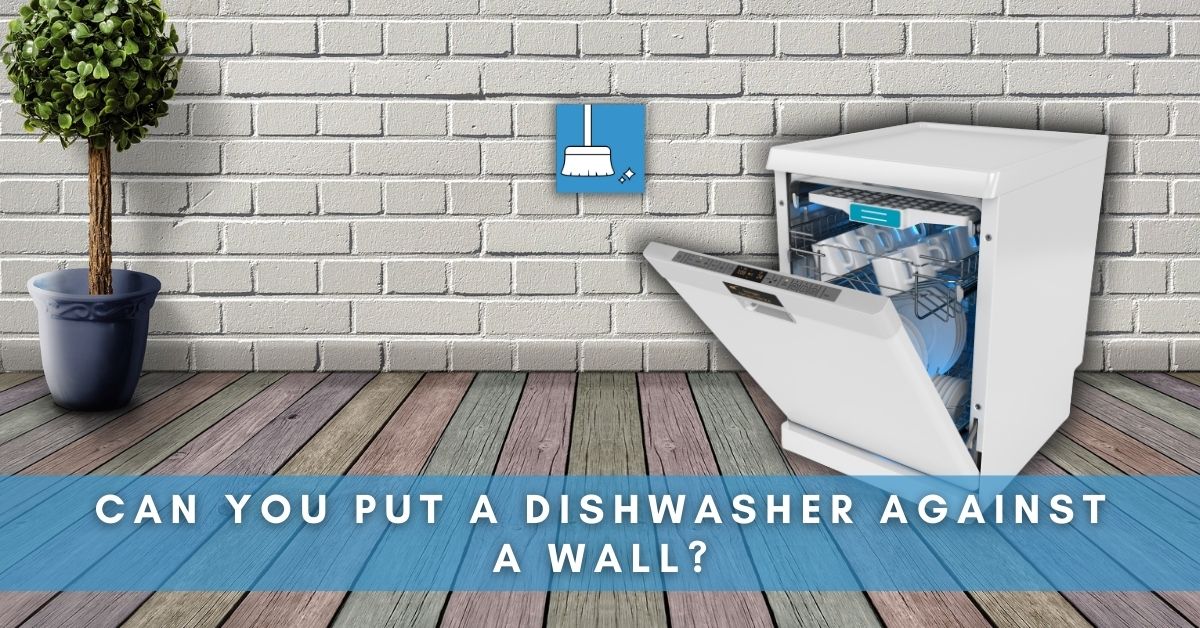You have just bought a new dishwasher, or maybe you are remodeling your kitchen. Where would the most ideal location be for your dishwasher? Could it be kept against the wall? Or used as a kitchen island if it is portable? How much space will it take up?
You will also need to consider where and how close to place your dishes and regularly used utensils, so they can be put away easily straight from the dishwasher. Read on to find out more about the ideal dishwasher location.
Can You Put a Dishwasher against a Wall?
Putting a dishwasher against a wall is not usually the norm, as it is not the ideal location for installing a dishwasher. Your dishwasher needs a water supply line, a drain line, and a connection to the power supply, all of which are found near the sink.
If you put a dishwasher against a wall, there must be a gap of at least 2″. This is because the dishwasher emits heat and humidity during the cycle, which can ruin your wall if there is not a suitable distance kept.
If it is a corner installation, you will still need to allow for a 2″ clearance between the wall and the dishwasher. You will also need to have a filler and side panel for the dishwasher to support the counter.
Dishwasher Location Rules
Before finalizing the location for your dishwasher, it is necessary to bear in mind certain guidelines:
1- Most designers will recommend the dishwasher be placed next to the kitchen. There are 2 reasons for this:
a) The dishes can be rinsed off in the sink and placed immediately in the dishwasher
b) The plumbing is easier as the dishwasher can be connected to the pipes supplying water to the sink
It does not matter if it is on the right side or left side of the sink. That is a personal choice.
2- Note that the dishwasher door when open, does not block any countertops which are frequently used. It should not block the pathway to the stove or oven either.
3- The distance between the kitchen cupboards and cabinets where the regularly used dishes and utensils are stored should not be more than a couple of steps from the dishwasher.
4- If the house has elderly people, the dishwasher can be elevated and placed in a cabinet that is slightly elevated.
5- If it is a portable dishwasher and is used as an extra countertop, dirty dishes may be placed on the countertop instead of the kitchen sink.
These then have to be taken to the kitchen sink for a slight rinse and then put in the dishwasher.
Wherever the dishwasher is installed, there should be freedom of movement, and the dishwasher door should not block any path or cabinet.
Do All Dishwashers Plug into the Wall?
Most dishwashers are usually hardwired to the electrical system of the house. This means that they are not plugged in. Dishwashers are hardwired as they need a lot of power to function. Hardwiring dishwashers prevents electrical accidents and faults.
Dishwashers can be converted to use a cord and plug unit, but this will need to be bought separately as they are not supplied with the dishwashers.
You may also need to check with your local area codes if you can convert the hardwired dishwasher to one which can be plugged in.
The following dishwashers are hardwired:
Built-in dishwashers – these are a permanent installation and fit in cabinets near the sink. There may be times when you can’t fit a dishwasher in a particular space, either due to new flooring or other reasons.
Integrated dishwashers – these are like built-in dishwashers and can be completely concealed in the kitchen
The following dishwashers are plugged in:
Portable dishwashers – these are freestanding dishwashers that can be moved around and used where there are appropriate plumbing and electrical requirements
Countertop dishwashers – these are smaller in size and can be placed on the countertops of your kitchen
Steps to Add a Cord and Plug to a Dishwasher
a) Disconnect the power supply to the dishwasher.
b) Power cords do not come with the dishwashers and have to be bought separately.
c) Find the junction box which is usually underneath the dishwasher and remove the cover
d) Attach the grounding wire by fastening it to the grounding connection in the junction box
e) Attach the black and white wires from the power cord to the respective black and white wires of the dishwasher. Twist the wires together (white with white and black with black) and tighten each pair with a wire cap
f) A strain relief is used to protect the power cord’s wires by securing the cord to the junction box
g) Return the wires to the junction box and secure the cover tightly.
h) The cord can now be plugged in.
How to Install a Dishwasher against a Wall
Important Considerations!
The following must be noted if you are going to install the dishwasher against a wall:
1- If you install a dishwasher against a wall in your kitchen, depending on the kitchen size, it may be slightly further away from your sink. However, the distance should not be more than 10 feet from the sink.
2- The dishwasher should be fully enclosed from the top, sides, and back.
3- Standard sizes of dishwasher hoses are 6 ½ feet. Hose extensions are available.
4- Ensure there are not too many corners from the dishwasher to the sink as this may cause water blockages.
5- The hoses and wires should not come into contact with the motor or legs of the dishwasher.
6- If it is a plug and cord dishwasher, do not use an extension cable. You may consider relocating the dishwasher to where it can be plugged in.
7- Ensure it is not too close to the wall as the humidity from the dishwasher can eventually cause mold on the wall.
Steps to Install a Dishwasher against a Wall
STEP 1: Disconnect the power and water supply lines.
STEP 2: Connect the water supply line to the dishwasher using a dishwasher 90. This supplies clean water to the dishwasher.
STEP 3: Connect the drain hose to the dishwasher. This drains the dirty water away from the dishwasher.
STEP 4: If the dishwasher is placed near the wall next to the cabinets, drill small holes in the cabinets and let the pipes through to reach the sink.
STEP 5: Connect the water supply hose to the shut-off valve on the hot water supply line.
STEP 6: Connect the drain hose to the drain trap below the sink. This can be done in 2 ways.
o Using an air gap which is a safety gadget that prevents dirty water from flowing back to the dishwasher
o Looping the hose to a point above the dishwasher to prevent the backflow of dirty water
STEP 7: Attach the electrical fittings. If the dishwasher needs to be hardwired, locate the junction box in the dishwasher. It will have a ground connection and black and white wires.
STEP 8: Connect the ground wire to the grounding inlet in the junction box. This is fastened with a nut and bolt. Then, connect the household wires to the dishwasher wires – black to black and white to white. Use twist-on wire connectors to connect these pairs.
STEP 9: Put the wires back in the junction box and secure the lid tightly.
STEP 10: Ensure the dishwasher is level with the ground. Dishwashers should never be installed on a carpet as they can overheat.
STEP 11: Reconnect the electricity and water supply line. The dishwasher is ready to use.
STEP 12: You may also need to drill holes in the wall to locate the water supply pipes. This is if the dishwasher is located far from the sink.
Areas Where a Dishwasher Should Not Be Installed
1- Do not place the dishwasher next to the refrigerator as dishwashers emit heat and humidity.
Installing a dishwasher near the refrigerator can interfere with the refrigerator’s ability to get rid of the condensation. While the dishwasher is running, the fridge will use extra power to maintain its temperature
2- A wall oven should also be kept 24″ apart from a dishwasher. The reason is to allow the heat from the oven to dissipate, without damaging the dishwasher.
The Ideal Place to Install a Dishwasher
The most practical place to install a dishwasher is near the sink. The water supply lines are already in place and the dishwasher can be hardwired to the electric wiring of the house.
It can be placed under the counter near the sink, and an integrated or semi-integrated dishwasher will blend into the kitchen aesthetics seamlessly.
If you opt for a portable dishwasher, it can be placed in a storage area when not in use. It can also be placed in the kitchen and used as an extra countertop for food preparation.
Final Thoughts!
Dishwashers and other appliances in the kitchen should be installed after consulting the instruction manual. It is important to know that certain appliances should not be placed next to each other.
The dishwasher should be placed in a way that makes it easy to load and unload and put away the washed dishes and utensils. It should also not obstruct any walkways when the door is opened.
If you are remodeling your kitchen, it is a good idea to consult a kitchen designer to give you the best options for the layout of your kitchen.





